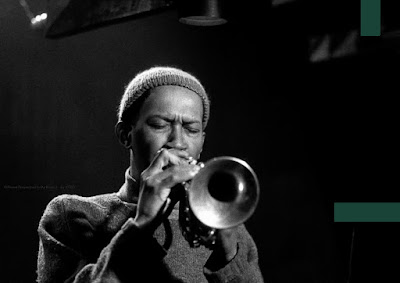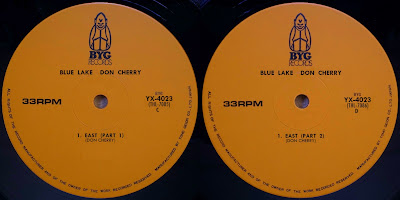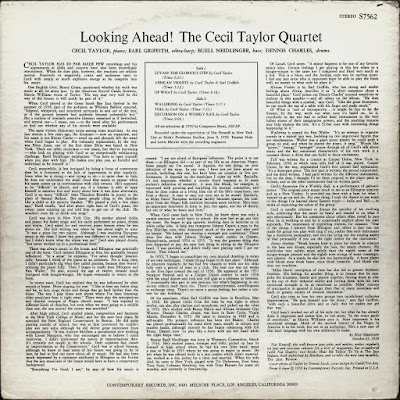Label: BYG Records – YX-4012-13
Format: 2 × Vinyl, LP, Album / Country: Japan / Released: 1973
Style: Free Jazz, Free Improvisation
Recorded in France, April 22 (B2, C1, C2) and August 11 (A, B1, D), 1971.
Artwork – Shigo Yamaguchi
Liner Notes [Japanese] – Masahiko Yuh
Photography By – Masatoshi Sunayama
Manufactured By – Toho Geion Co., Ltd.
A - Orient (Part-1) .................................................................... 16:21
B1 - Orient (Part-2) .................................................................... 8:57
B2 - Eagle Eye (Part-1) ............................................................... 6:50
C1 - Eagle Eye (Part-2) ............................................................... 5:31
C2 - Togetherness ..................................................................... 11:41
D - Si Ta Ra Ma ....................................................................... 19:30
All compositions written-by – Don Cherry
Musicians:
A-B1 - "ORIENT (Parts 1 and 2" / D - "SI TA RA MA"
Don Cherry – pocket trumpet, flute, piano, vocals
Han Bennink – drums, percussion, accordion, vocals
Mocqui Cherry – tambura
B2-C1 - "EAGLE EYE (Parts 1 and 2)" / C2 - "TOGETHERNESS"
Don Cherry – pocket trumpet, flute, piano, vocals
Johnny Dyani – bass
Okay Temiz – drums, percussion
Orient is a live album by jazz/world music musician Don Cherry recorded in 1971 and first released on the BYG label in Japan in 1973, originally untitled.![]()
Orient captures the nomadic Don Cherry in two live sets in the early '70s with two different trios. Cherry's work from about 1967-1978 was concentrated in his desire to bring to bear as many influences from musical cultures around the globe as possible into his music. Prominent among these include Indonesian gamelan, Indian Karnatic singing, rhythms from West and South Africa, and American Indian rituals. Also common during this period was Cherry's tendency to spend equal time on piano, flutes, and vocals alongside his pocket trumpet. All of these figure into the two sets here, one including the great Dutch drummer Han Bennink, the other with the amazing South African bassist Johnny Dyani. Fans of Cherry will recognize several of the themes herein, including the very beautiful "Desireless" from his Relativity Suite, but it's fascinating to hear him work in material from Indian scales to township dance music to Herbie Hancock's "Maiden Voyage." Orient is definitely a valuable document and recommended.
![]()
![]()
![]()
![]()
![]()
_1. Jazz music has never had the influence or monetary sway that pop or rock has had. It has had (when distilled to its most primal impulses) the temperament of defiant ingenuity and an eager willingness to always be open and ready for anything. In this respect, jazz is at once self-serving and giving in both its musical and cultural exchange.
Many jazz artists have experimented with sounds from all over the globe, helping give shape and form to what has come to be known as “fusion jazz” (jazz’s sometimes unfortunate offshoot). One artist conspired to go beyond all borders, confines and genres to create a highly expressive and unique presentation of melding cultures—jazz rethought and relived in the constant grind of invention. Don Cherry, born 1936, would essentially become the harbinger of a melting pot consciousness.
Having first learned the ropes as player in Ornette Coleman’s boundary-breaking and highly influential collective, Cherry first appropriated the stylings of Coleman’s free jazz workings, abandoning structure and form for free tonality. After his notable work on Coleman’s groundbreaking album, The Shape of Jazz to Come, Cherry would strike out on his own with a number of significant recordings for Blue Note, including Complete Communion and Symphony for Improvisers.
These two albums were a far cry from the globe-trotting material Cherry would explore in his later years, but they hinted at the exotic musical delights of which the artist was enamoured with. In Symphony for Improvisers, one hears only the faintest traces of Latin influences that would eventually blossom on future recordings...
_2. If anyone wanted to closely pinpoint where jazz opened up to a world and wealth of new sounds, they might look towards Cherry’s Mu, released in 1969. This recording is now regarded as a landmark work which introduced the world to a bevy of global sounds, including Indian Karnatic music, Latin and African percussion, Arabic scales and Native American folk. The blend of these worldly sounds are, surprisingly, undisturbed by the volatile cadences of Cherry’s jazz; they never dissolve into the heated flows of rhythm—they simply become the elemental grafts on the scrim of which Cherry conceives his designs.
Mu would simply be the beginning of a series of works that would expand upon the disparate influences that Cherry would pick up on his travels from around the world, each album exploring the respective culture he found himself immersed in at the time. Spells in places like Morocco, Turkey, France and the Far East would transform the artist into a roving human sponge, soaking up every curious sound laid bare to him by a newfound friend. Cherry made a lot of friends, in fact, and it was not unusual for many of them to become members of his constantly rotating collective.
Orient (1971) detailed Cherry’s adventurous and romantic exploits in the Far East and his hypnotic strains of Oriental instrumentation found a perfect and unlikely match in the alternately storming and restrained drum work of Hans Bennink and Okay Temiz. Tracks like “Si Ta Ra Ma” examined the shamanistic interiors of the soul with Cherry exploring traditions of Hoomii, the throat-singing of Mongolia.
Elsewhere, the jazz elements took precedent, such as on the frenetic crash-and-burn rhythms of the title-track. Cherry would push even further into Eastern sounds on the eerie, esoteric Organic Music Society, which further ploughed the depths of Indian mysticism he touched upon on Orient. By this time, the artist had fully steeped himself in the fashion of the times; Eastern philosophy, psychedelia and Zen teachings (introduced into public consciousness by the rise of hippie culture) were an integral part of Cherry’s work...
DON CHERRY – Blue Lake (2LP-1974)
Label: BYG Records – YX-4022/4023
Format: 2 × Vinyl, LP, Album / Country: Japan / Released: 1974
Style: Free Jazz, Free Improvisation
Recorded live in Paris, France on April 22, 1971.
Liner Notes [Japanese] – Masahiko Yuh
Photography By – Masatoshi Sunayama
A1- Blue Lake .............................................................................. 4:55
Written-By – Don Cherry
A2- Dollar And Okay's Tunes (Part 1) ........................................ 17:05
Written-By – Dollar Brand, Okay Temiz
B - Dollar And Okay's Tunes (Part 2) ........................................ 15:14
Written-By – Dollar Brand, Okay Temiz
C - East (Part 1) ......................................................................... 13:10
Written-By – Don Cherry
D - East (Part 2) ......................................................................... 13:42
Written-By – Don Cherry
Personnel:
Don Cherry – pocket trumpet, piano, flute, vocals
Johnny Dyani – bass
Okay Temiz – drums, percussion
Blue Lake is a live album by jazz/world musician Don Cherry recorded in 1971 and first released on the BYG label in Japan in 1974.
![]()
This live set, Blue Lake, is a worthy introduction to his solo work. The first part of the set begins with Cherry on a Native American flute. His simple song is as moving and spare as a New Mexico mesa. Next, he and his band move into their interpretation of some Dollar Brand tunes. First, they lay the melodies out straight and give the audience a window into this neglected composer's mind. Then it's time for their ferocious, free-wheeling, Ornette Colemanesque take on the same tunes. The last brace of tunes finds Cherry mostly singing á la Sam Rivers. Like Rivers' voicings, one forgets that this is a man, and hears only another instrument. Just when the tension rises to almost unbearable levels, Cherry breaks loose with some forceful, controlled soloing. The tone is muscular, and the ideas as sure and stringent as bitter salt. Cherry's journey as a musician has been that of a consummate artist. His remarkable career deserves stricter attention from fans and critics alike.
![]()
![]()
_3. It wasn’t until 1975, however, that Cherry’s fusion between the core jazz elements of his work and the ethnic influences he experimented with truly found the musical equilibrium he had been seeking for years. Brown Rice, a smorgasbord of international flavours that pulled from every corner of the world, was infused with the renewed electricity of the burgeoning funk scene that bled over rock, pop and disco. The album’s title-track is pure kitchen-sink drama (that would be everything and the sink); warbles of cosmic funk intermingle with saxophone skronks and electro-bongos to create the closest thing a jazz artist could ever come to pop. It was not just new ground for Cherry but for jazz as well, and the remaining album cuts showcased an even deeper understanding of global-pop aesthetics.
In the heart of the album the two numbers, “Malkauns” and “Chenrezig”, were further travels along the astral bodies of spiritual sounds; mired in the trance-inducing thrums of Charlie Haden’s bass, the two cuts pointed, once again, toward Cherry’s previous influences of Indian ragas. A daring, peculiar and darkly mysterious effort, Brown Rice has also proven to be one of Cherry’s most misunderstood recordings. Drawing a clear line between jazz purists and fusion enthusiasts, Brown Rice has continued to polarize fans of both Cherry and jazz in general, a testament to the artist’s ability to provoke and stir listeners by the sheer force and flow of ideas alone...
![]()
![]()
_4. One of Don Cherry’s last excursions into music was Multikulti, his 1991 effort that refined some of the rougher edges of his earlier work for a smoother confluence of multicultural sounds. A notable release that garnered some praise for Cherry’s ability to incorporate newer, contemporary influences, Multikulti can be seen as a bridge that unifies the emotional impulses of both pop and jazz.
A few years later following Multikulti, Cherry would pass away from liver failure, having left behind a legacy of work not always rightfully acknowledged or widely embraced. His stepdaughter, Neneh (who’s own work has encompassed everything from hip-hop and punk to R&B, jazz and pop), had already reached a level of fame around this time with her own inspired brand of music, no doubt influenced by her stepfather.
It was reported once that Neneh had stated that artistic success depended on good ideas rather than expertise. This sentiment echoes both the struggles and triumphs that her stepfather would undertake throughout the trajectory of his career; true enough, Cherry, at times, was criticized for his technique. Yet it was the constantly renewed energy of spontaneity and joy alone that gave him his musical longevity. Cherry’s travels stopped in 1995, the year of his passing. Nearly 20 years later, his music continues to travel – through the world, space, time, mind, soul…
I'm offering you today only a small fragment of his genius. Enjoy!
If you find them, buy these albums!






































































































































































